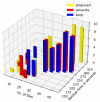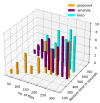Plant and Salamander Inspired Network Attack Detection and Data Recovery Model
- PMID: 37420729
- PMCID: PMC10302505
- DOI: 10.3390/s23125562
Plant and Salamander Inspired Network Attack Detection and Data Recovery Model
Abstract
The number of users of the Internet has been continuously rising, with an estimated 5.1 billion users in 2023, which comprises around 64.7% of the total world population. This indicates the rise of more connected devices to the network. On average, 30,000 websites are hacked daily, and nearly 64% of companies worldwide experience at least one type of cyberattack. As per IDC's 2022 Ransomware study, two-thirds of global organizations were hit by a ransomware attack that year. This creates the desire for a more robust and evolutionary attack detection and recovery model. One aspect of the study is the bio-inspiration models. This is because of the natural ability of living organisms to withstand various odd circumstances and overcome them with an optimization strategy. In contrast to the limitations of machine learning models with the need for quality datasets and computational availability, bio-inspired models can perform in low computational environments, and their performances are designed to evolve naturally with time. This study concentrates on exploring the evolutionary defence mechanism in plants and understanding how plants react to any known external attacks and how the response mechanism changes to unknown attacks. This study also explores how regenerative models, such as salamander limb regeneration, could build a network recovery system where services could be automatically activated after a network attack, and data could be recovered automatically by the network after a ransomware-like attack. The performance of the proposed model is compared to open-source IDS Snort and data recovery systems such as Burp and Casandra.
Keywords: bio-inspired algorithm; evolutionary computing; intrusion detection; network security; ransomware.
Conflict of interest statement
The authors declare no conflict of interest.
Figures

















Similar articles
-
A Survey of Crypto Ransomware Attack Detection Methodologies: An Evolving Outlook.Sensors (Basel). 2022 Feb 25;22(5):1837. doi: 10.3390/s22051837. Sensors (Basel). 2022. PMID: 35270983 Free PMC article. Review.
-
Cyber-Internet Security Framework to Conquer Energy-Related Attacks on the Internet of Things with Machine Learning Techniques.Comput Intell Neurosci. 2022 Sep 29;2022:8803586. doi: 10.1155/2022/8803586. eCollection 2022. Comput Intell Neurosci. 2022. PMID: 36210975 Free PMC article.
-
Detection of Middlebox-Based Attacks in Healthcare Internet of Things Using Multiple Machine Learning Models.Comput Intell Neurosci. 2022 Nov 28;2022:2037954. doi: 10.1155/2022/2037954. eCollection 2022. Comput Intell Neurosci. 2022. PMID: 36479020 Free PMC article.
-
Customised Intrusion Detection for an Industrial IoT Heterogeneous Network Based on Machine Learning Algorithms Called FTL-CID.Sensors (Basel). 2022 Dec 28;23(1):321. doi: 10.3390/s23010321. Sensors (Basel). 2022. PMID: 36616920 Free PMC article.
-
A comprehensive survey of AI-enabled phishing attacks detection techniques.Telecommun Syst. 2021;76(1):139-154. doi: 10.1007/s11235-020-00733-2. Epub 2020 Oct 23. Telecommun Syst. 2021. PMID: 33110340 Free PMC article. Review.
Cited by
-
Coli bond: A dual-function encryption system for secure information storage and transmission by microorganisms.PLoS One. 2025 Jun 11;20(6):e0325926. doi: 10.1371/journal.pone.0325926. eCollection 2025. PLoS One. 2025. PMID: 40498745 Free PMC article.
References
-
- Demertzis K., Iliadis L. Computation, Cryptography, and Network Security. Springer; Berlin/Heidelberg, Germany: 2015. A bio-inspired hybrid artificial intelligence framework for cybersecurity; pp. 161–193.
-
- Thakkar A., Lohiya R. Swarm and Evolutionary Computation. Elseiver; Amsterdam, The Netherlands: 2019. Role of Swarm and evolutionary algorithms for intrusion detection system: A survey.
-
- Chen Y., Abraham A., Yang B. Hybrid flexible neural- tree-based intrusion detection systems. Int. J. Intell. Syst. 2007;22:337–352. doi: 10.1002/int.20203. - DOI
-
- Neelima D., Karthik J., Aravind John K., Gowthami S., Nayak J. Soft Computing in Data Analytics. Springer; Singapore: 2019. Soft Computing-Based Intrusion Detection Approaches: An Analytical Study; pp. 635–651.
MeSH terms
LinkOut - more resources
Full Text Sources
Research Materials

